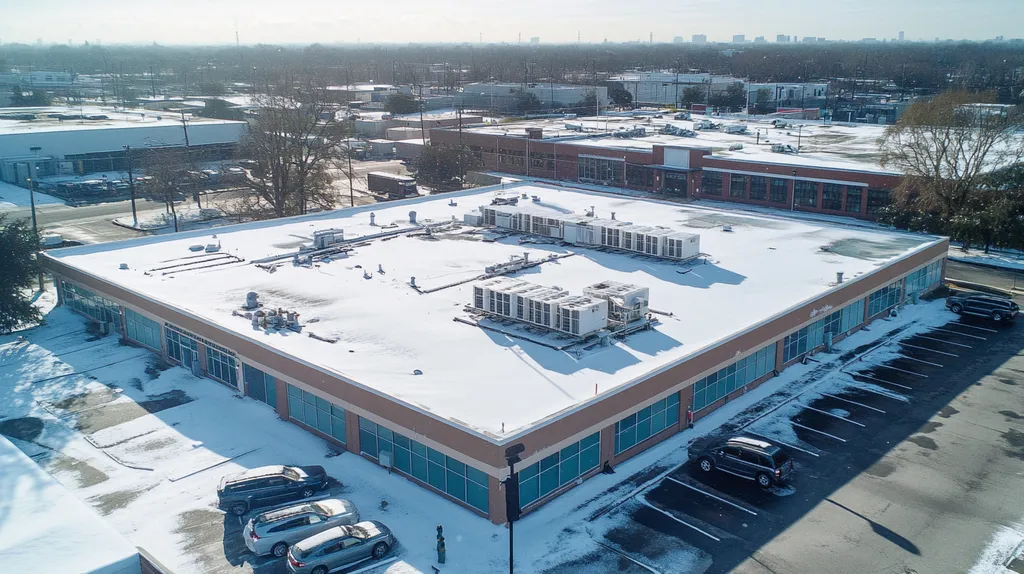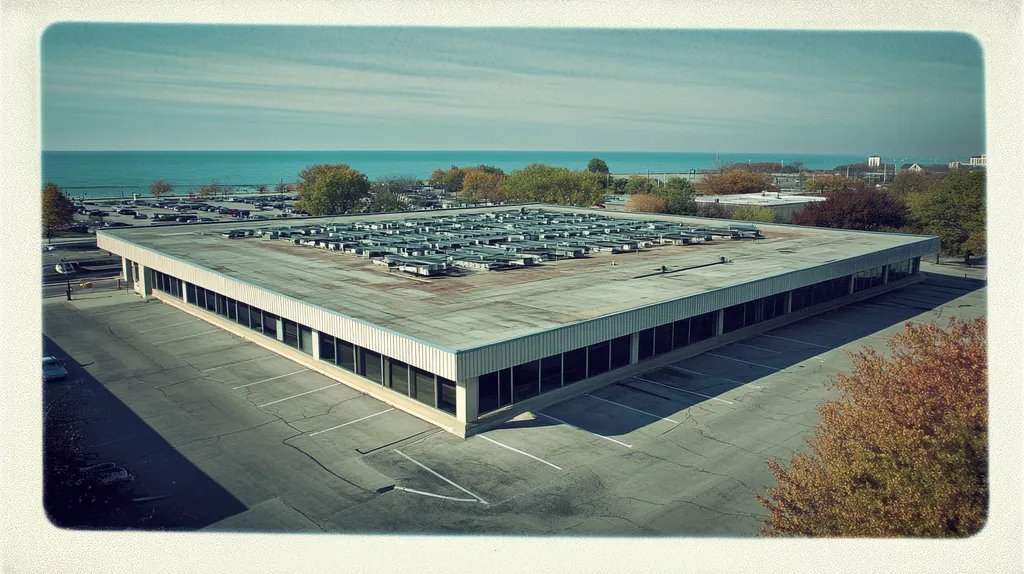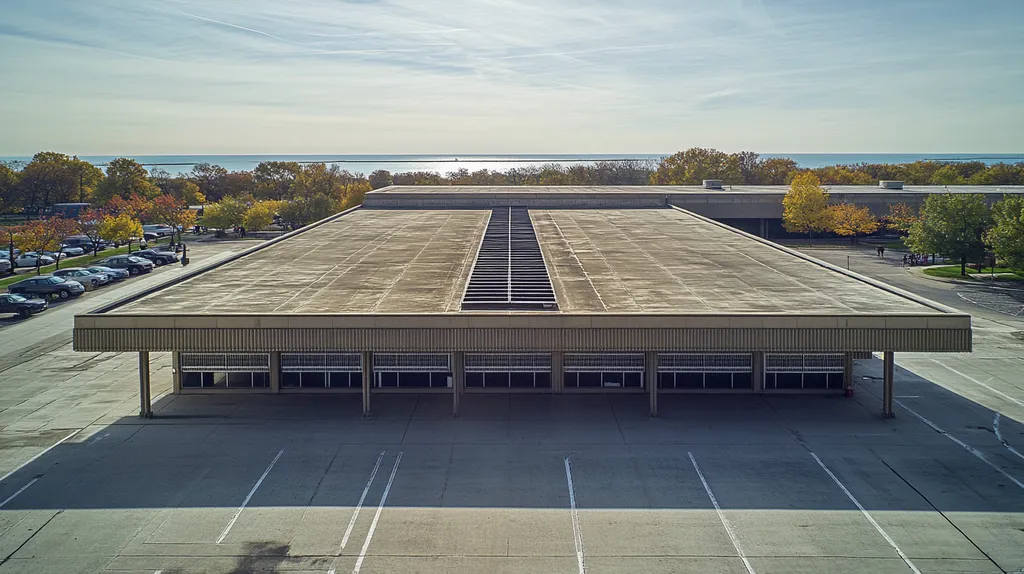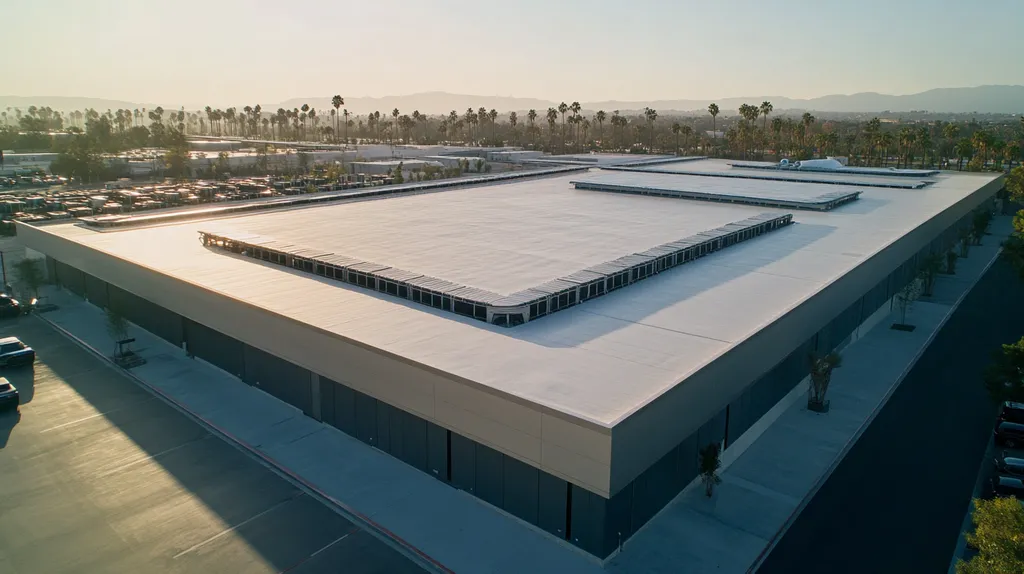In today’s complex industrial landscape, regional building codes have evolved from simple guidelines into make-or-break regulations that determine a facility’s operational future. Recent studies show that over 40% of industrial roofing failures stem directly from code violations, resulting in millions in damages annually.
From snow load requirements in northern states to hurricane resistance standards along coastlines, these regional variations create a maze of compliance challenges for property owners and facility managers.
This comprehensive guide separates fact from fiction, examining how local codes impact everything from material selection to long-term maintenance while offering practical solutions for navigating these critical requirements.
SECTION 1: COMMON MISCONCEPTIONS
In the realm of industrial roofing, many property owners and facility managers underestimate how vital regional building codes truly are. These codes are more than simple guidelines; they are enforceable regulations that govern safety, efficiency, and overall building performance. Neglecting them can result in hefty fines, extended project delays, and, in extreme instances, unsafe working conditions. Studies have shown that failing to comply with these regulations can increase risks of structural failure by as much as 30%.
Ignoring Local Building Codes
A prevalent misconception is that local building codes can be bypassed without repercussions. Some property owners may assume their projects are on track for inspection without fully understanding the local regulations. However, non-compliance can lead to fines, delays, or even legal challenges.
In severe cases, overlooking these codes can jeopardize lives. For example, a manufacturing facility that disregards local roof load requirements risks catastrophic failure during extreme weather, potentially endangering employees and exposing the company to lawsuits and severe financial losses.
Taking the time to comprehend local codes is essential. Collaborating with a local roofing expert can yield important insights that mitigate these risks. Their specialized knowledge ensures that every decision made is compliant, enhancing the safety of both the property and its occupants.
Additionally, many codes include energy efficiency benchmarks. Ignoring these not only raises regulatory concerns but may also inflate long-term operational expenses. Prioritizing compliance can elevate building performance and sustainability.
Assuming Universal Material Standards
Another common myth is that roofing material standards are consistent throughout the industry. Many facility managers operate under the assumption that any material meeting general specifications will be adequate everywhere. This is a dangerous misconception.
In truth, each region may impose unique demands influenced by regional climate, weather conditions, and specific building uses. For instance, materials designed to withstand the heavy snow loads typical in northern states may not hold up well in southern areas that frequently face hurricanes.
Using unsuitable materials can lead to premature roof damage, resulting in expensive repairs or replacements. Furthermore, suppliers might refrain from offering performance guarantees if local jurisdictions have stringent material standards. This leaves property owners vulnerable to unexpected costs.
Consulting with experts who understand regional material requirements allows managers to select the right roofing systems. This strategic approach safeguards the investment and promotes long-lasting performance.
Overlooking Zoning Regulations
Finally, failing to consider zoning regulations is a common mistake among property owners. They may operate under the false assumption that compliance with building codes automatically resolves any zoning concerns. This notion is misguided.
Zoning laws dictate how properties can be utilized, and they can significantly affect roofing designs. For example, specific zones may impose limits on roof height or require distinct architectural features. Ignoring these stipulations could lead to penalties and disrupt business operations.
In some cases, non-compliance with zoning regulations might necessitate costly roof modifications. Such adjustments are often more expensive than if the property owner had proactively incorporated compliance measures from the outset. Building connections with local zoning officials can provide clarity and help avert potential conflicts.
By integrating zoning regulations into roofing plans from the beginning, property managers can prevent unnecessary delays and complications. Prioritizing compliance not only fosters long-term success but also contributes to a sustainable future for the property.
SECTION 2: PRACTICAL IMPLICATIONS
Grasping the relevance of regional codes is essential for industrial roofs to meet critical safety standards and operational demands. Ignoring these codes can lead not only to severe financial penalties but also to disastrous roof failures, placing lives at risk. The National Roofing Contractors Association highlights that inadequate roofing compliance contributes to over $500 million in property damage each year. This section delves into the implications of these codes regarding structural integrity, material selection, and inspection requirements.
Structural Integrity and Safety
The structural integrity of a roof remains a cornerstone of any industrial facility’s safety. Regional codes often impose specific load requirements to account for local weather conditions, seismic activity, and building usage. For example, in regions facing heavy snowfall, roofs may need additional reinforcement to support the heightened weight.
Moreover, safety regulations often stipulate the installation of crucial features like parapets or guardrails that safeguard workers during maintenance tasks. Facilities that overlook these guidelines risk not only injuries but also increased insurance premiums and potential legal repercussions.
Ignoring structural requirements can culminate in catastrophic failures, endangering employee safety and jeopardizing business continuity. It is vital to stay informed about how these codes apply locally to ensure that roofs can endure environmental stresses over time.
Recent assessments reveal that around 30% of industrial roofs situated in high-risk zones fail to meet required codes. This statistic underscores the imperative of prioritizing compliance to protect both property and personnel.
Material Compliance and Selection
When selecting roofing materials, adherence to regional codes becomes a decisive factor. These codes may outline specific requirements for materials based on their ability to resist fire, moisture, or UV exposure, tailored to the climate and local risk factors.
For instance, areas grappling with extreme heat may mandate reflective roofing materials that help lower energy costs and boost building efficiency. Conversely, regions susceptible to heavy rainfall might require water-resistant materials to thwart leaks and prevent structural damage.
Failing to choose compliant materials can lead to expensive renovations and ongoing maintenance due to premature wear or damage. Property owners must consult both local codes and manufacturers to ensure the selection of materials that adhere to performance standards.
Statistics indicate that over 40% of industrial roofing failures stem from improper material choices. This reinforces the necessity for informed decision-making to guarantee durability and adherence to regional regulations.
Inspection and Permit Requirements
Conducting regular inspections and securing necessary permits are vital components of industrial roofing compliance. Most regional codes mandate formal inspections at various stages of the roofing process, from initial design to final installation.
These inspections facilitate adherence to safety and construction standards, aiding in the prevention of future complications. Facilities that bypass inspections may face violations, resulting in fines and costly retrofits that strain their operational budgets.
Furthermore, the permitting process is designed to ensure that roofs comply with local and state regulations, encompassing environmental impact assessments. Without obtaining proper permits, companies risk encountering legal challenges that could halt operations and inflict reputational damage.
Research suggests that around 25% of roofing projects fail to secure the necessary permits, exposing companies to considerable risks. By understanding inspection and permit requirements, property owners can protect their investments and enhance overall roofing performance.
SECTION 3: COST OF MISINFORMATION
The stakes surrounding regional codes for industrial roofing have never been higher. Non-compliance can result in substantial fines, legal troubles, and costly project delays. Recent studies reveal that fines for code violations can soar into the tens of thousands, severely impacting a company’s financial health. Property owners and facility managers must grasp these risks to effectively navigate their roofing projects and safeguard their investments.
Fines and Penalties for Non-Compliance
Overlooking or misinterpreting regional roofing codes can unleash serious financial penalties. Local authorities often impose fines that vary considerably based on the violation’s severity, occasionally climbing into the five-figure range. Such financial burdens can disrupt operating budgets and long-term planning efforts.
Besides direct fines, businesses may accrue additional expenses linked to reapplying for permits, scheduling inspections, and making necessary corrections. These unplanned costs can divert vital resources away from other pressing projects.
Some jurisdictions enforce a tiered penalty system, where repeat offenses lead to progressively steeper fines. A seemingly minor oversight can snowball into a hefty financial drain, underlining the importance of straightforward compliance with local codes.
To avoid these financial pitfalls, staying informed about local codes is crucial. Regular training and updates for staff can bolster compliance efforts and help protect against unnecessary penalties.
Legal Liability and Litigation
Misinformation about regional codes can expose property owners to legal challenges. If code violations create unsafe environments, tenants or neighboring businesses may pursue legal action. The financial implications of such lawsuits can be staggering and can tarnish a company’s reputation.
Litigation linked to non-compliance typically incurs high legal fees and might result in settlements that eclipse initial project budgets. These setbacks can impede business operations for an extended period, creating long-lasting difficulties.
Moreover, liability insurance might not cover incidents directly tied to code violations, placing property owners at financial risk. This reality highlights the paramount need for rigorous adherence to roofing codes.
Engaging seasoned professionals who understand the intricacies of local regulations can mitigate these legal risks. Investing in expert guidance can serve as a protective barrier against potential legal repercussions.
Project Delays and Cost Overruns
One of the most immediate consequences of misinformation is project delays. Non-compliance can compel local authorities to conduct inspections, halting progress until issues are resolved. Such interruptions can elongate timelines and disrupt operational plans for businesses.
Delays frequently lead to cost overruns, as contractors may charge additional fees for extending their services. Each day a project is stalled can inflate material costs, thereby increasing the overall financial burden associated with the project.
Furthermore, the productivity losses stemming from these delays can resonate throughout the organization. Employees may face operational inefficiencies, and existing contractual obligations may become endangered.
By prioritizing an accurate understanding of regional codes, property owners can keep projects on track and avoid costly setbacks. Proper planning and compliance are crucial components for maintaining timelines and adhering to budget constraints.
SECTION 4: REALITY CHECK
Understanding regional codes isn’t merely a box to check; it is a lifeline for the durability and efficiency of industrial roofing systems. Consider regions susceptible to heavy snowfall, which require roofs designed with enhanced load-bearing capacities. Adhering to local codes safeguards against costly failures and guarantees that facilities perform reliably under diverse environmental conditions.
Understanding Regional Climate Requirements
Climate undeniably shapes roofing regulations, and local weather patterns dictate specific mandates. Areas with extreme heat impose stringent ventilation and insulation standards to minimize energy consumption. Conversely, colder regions must design roofs that can handle snow loads and prevent ice dam formation.
The International Building Code (IBC) provides a framework for these minimum design requirements by region. This ensures roofs are equipped to withstand local environmental pressures, thereby mitigating risks of structural failure and liability.
Failure to comply with these regulations can have dire consequences. Poorly designed roofs might lead to leaks, structural damage, or even collapse, all of which require expensive repairs and compromise safety.
Understanding these climate-specific requirements empowers property owners to select appropriate materials and design approaches, ultimately enhancing safety and extending roof lifespan.
Energy Efficiency and Cool Roof Standards
Energy efficiency has evolved from an option to a necessity, driven by regional codes focused on mitigating environmental impacts. Numerous areas now enforce cool roof standards that require reflective surfaces to reduce heat absorption.
According to the U.S. Department of Energy, cool roofs can decrease surface temperatures by as much as 50°F on sunny days. This significant reduction not only cuts energy costs but also diminishes the urban heat island effect.
Failing to adhere to these energy-efficiency standards can cause higher operational costs and invite penalties. By opting for cool roofing materials, businesses can significantly lessen their energy footprint while ensuring compliance with local regulations.
In essence, embracing energy efficiency codes is crucial for operational sustainability and improving a building’s marketability.
Fire Resistance and Waterproofing Mandates
Fire resistance and waterproofing are fundamental for ensuring safety and protecting against property damage. Many states enforce strict fire code regulations that set minimum fire resistance ratings for roofing materials, especially for commercial applications.
In some regions, there are specific requirements for Class A fire-rated roofing systems to defend against both wildfires and urban areas. Meeting these regulations is vital for the protection of structures, surrounding properties, and personnel.
Waterproofing also occupies a central role in regional mandates, particularly where heavy rainfall or snow is common. Inadequate waterproofing can lead to significant damage from leaks, jeopardizing both the structural integrity and the well-being of occupants.
Addressing these fire resistance and waterproofing requirements not only helps property owners protect their investments but also affirms compliance with local laws, thereby enhancing overall asset value.
SECTION 5: EVIDENCE-BASED ALTERNATIVES
The importance of making informed industrial roofing decisions cannot be overstated. With research indicating that improper material selections can lead to premature roof failures, businesses risk losing thousands in repair costs and lost productivity. Property owners and facility managers must be aware of evidence-based alternatives that will steer them toward sound choices. This section highlights the significance of using authorized roofing materials, implementing intelligent rooftop monitoring, and adhering to local energy codes.
Using Authorized Roofing Materials
Selecting authorized roofing materials is pivotal for ensuring long-term roof performance and compliance with regional codes. Utilizing materials that meet local standards not only enhances durability but also reduces liabilities for property owners. For instance, opting for Class A fire-rated roofing systems not only protects against fire hazards but can also lower insurance premiums.
Moreover, materials with proven energy efficiency can decrease utility bills significantly. Reflective membrane systems, for example, help regulate building temperatures, reducing the stress on HVAC systems. Choosing sustainable options like cool roofs boosts a company’s public image while contributing to environmental initiatives.
Proper material selection can also streamline the inspection and permitting process, enhancing compliance with local building codes. Proactive choices in materials can help minimize the need for costly modifications down the line. Property owners should work closely with experts to verify material certifications, ensuring they meet both regional standards and project specifications.
Ultimately, selecting the right authorized roofing materials protects not just the buildings but also the investments and reputations of businesses. Wise choices in this area can yield significant dividends in performance and compliance.
Implementing Intelligent Rooftop Monitoring
Introducing intelligent rooftop monitoring technologies represents a forward-thinking approach to roof management that can significantly enhance operational efficiency. These systems provide real-time insights into the roof’s condition, allowing for the detection of potential issues before they escalate into costly repairs. For example, sensors can identify moisture accumulation, enabling timely interventions.
Adopting these advanced technologies not only prolongs the life of the roof but also enhances overall safety. By anticipating maintenance needs, property managers can ensure that roofs remain functional and compliant with safety regulations. Regular monitoring also aligns with energy efficiency initiatives, allowing for prompt resolution of issues to maintain optimal performance.
The financial benefits are notable. Studies show that organizations utilizing intelligent monitoring can cut maintenance expenditures by as much as 30%. Early problem detection also minimizes the chances of operational downtime, which can be particularly harmful in an industrial context.
Furthermore, integrating these monitoring systems supports compliance with local energy mandates and sustainability goals. With accurate data at their fingertips, decision-makers can make informed choices regarding repairs, retrofitting, or even replacements, establishing this technology as a crucial aspect of modern roofing strategies.
Adhering to Local Energy Codes
Compliance with local energy codes goes beyond merely adhering to regulations; it reflects a dedication to sustainability and operational efficiency. An increasing number of regions are adopting stringent energy codes designed to lower carbon footprints. These codes directly influence roofing materials, insulation standards, and overall energy performance.
By properly adhering to these codes, property owners can unlock significant incentives, including tax breaks and rebates. Roofs engineered to meet or exceed energy efficiency standards may qualify for local incentives that reduce operating expenses, ensuring regulatory compliance also translates into financial benefits.
Conversely, non-compliance risks incurring hefty fines and necessitating expensive rework, disrupting business operations and tarnishing a company’s reputation. Property owners need to stay informed about the latest regional codes that apply to their projects and adapt their roofing strategies accordingly.
Lastly, collaborating with knowledgeable contractors who understand local energy codes is vital. Such professionals provide invaluable insights, ensuring projects are compliant while maximizing financial and operational benefits. This cooperative approach aligns seamlessly with broader energy management strategies, fostering a culture of responsibility and sustainability.
SECTION 6: TEST AND VERIFY
The integrity of an industrial roof is a critical component of safe and efficient operations. With studies revealing that improper installations account for up to 30% of roofing failures, the stakes for property owners and facility managers are high. The costs associated with repairs and safety hazards can significantly impact a facility’s bottom line. Hence, prioritizing testing and verification at every stage of roofing construction is paramount. This section outlines the essential practices for conducting pre-roofing assessments, mid-project evaluations, and post-installation inspections to ensure compliance with regional codes and standards.
Conducting Pre-Roofing Assessments
Pre-roofing assessments are vital for laying the groundwork of a successful roofing project. These evaluations focus on crucial elements like existing structures, drainage systems, and local environmental conditions. Skipping this step can lead to unforeseen complications during installation, potentially putting the entire project at risk.
For instance, a failure to analyze the underlying structural components may uncover issues such as rot or corrosion that need addressing before any roofing work begins. Engaging qualified roofing professionals to conduct these assessments can uncover these risks early and ensure compliance with local codes. Keeping thorough documentation during this stage is also essential to protect property owners in future disputes.
Understanding the local regulations during the pre-assessment phase is essential for effective planning. This proactive approach not only helps avoid penalties but also ensures that the final roofing project meets safety regulations. Moreover, pre-roofing assessments enable efficient resource allocation, which can help reduce overall project costs.
Mid-Project Evaluations and Compliance Checks
Mid-project evaluations play a crucial role in maintaining compliance and safeguarding quality throughout the roofing installation. Regular inspections by qualified professionals ensure that the project adheres to design specifications and local codes, helping to catch and remedy potential issues before they become serious problems.
For example, if roofing materials fail to meet durability standards, mid-project checks provide the opportunity for timely corrections—whether that involves changing materials or refining installation techniques. Ongoing communication between project managers and roofing teams is vital during this phase, clarifying expectations and ensuring alignment with local requirements.
Documenting progress during these evaluations enhances accountability and provides a useful record for future projects. Industry best practices suggest conducting these evaluations at key milestones, reinforcing compliance while ensuring quality assurance throughout the roofing lifecycle.
Post-Installation Inspections and Maintenance Plans
After roofing installation, post-installation inspections are essential for verifying compliance with all regional standards. This comprehensive assessment should review various aspects, from structural integrity to insulation efficiency. A thorough inspection can reveal issues that compromise the roof’s durability and lifespan.
Documenting the findings of these inspections not only serves as proof of compliance but is also invaluable for warranty claims or insurance needs. Furthermore, these insights can guide property owners in creating effective maintenance plans to prolong roof life.
Establishing a proactive maintenance strategy helps mitigate long-term costs and boosts performance. Addressing minor issues identified during the post-installation inspection can prevent them from escalating into more significant, costly repairs.
Incorporating testing and verification as core components of the roofing process not only upholds compliance with regional codes but also significantly enhances the overall durability and reliability of the roofing system.
Looking Ahead
The industrial roofing landscape has evolved dramatically since the days of simple tar-and-gravel installations, with regional building codes now serving as the cornerstone of safety and compliance.
Recent studies showing that 40% of industrial roof failures stem from code violations underscore the critical nature of these requirements.
As climate patterns shift and energy efficiency standards tighten, facility managers must recognize that regional codes are not mere suggestions but essential safeguards protecting millions in assets.
The cost of non-compliance – from direct penalties averaging $25,000 to project delays lasting months – demonstrates why understanding and following local regulations is no longer optional.
Looking ahead, successful industrial roofing projects will depend on embracing these codes not as obstacles, but as frameworks for ensuring long-term structural integrity and operational excellence.
FREQUENTLY ASKED QUESTIONS
Q. What are the misconceptions about commercial roofing codes?
A. Many property owners mistakenly believe they can overlook local roofing codes. This misconception can lead to legal liabilities and increased costs due to fines and project delays. Engaging local roofing experts helps clarify the importance of compliance, ensuring safety and enhancing building performance.
Q. How does ignoring regional codes affect industrial roofs?
A. Neglecting regional codes can severely endanger the structural integrity of industrial roofs. Such oversight may lead to costly failures, legal repercussions, and jeopardize worker safety. It’s essential to understand these codes to protect investments and ensure compliance with safety regulations.
Q. What are the costs related to misinformation about roofing codes?
A. Misinformation regarding roofing codes can lead to substantial fines and legal fees. Projects may face costly delays due to non-compliance, further straining budgets. Understanding and adhering to local regulations is crucial to avoid these financial pitfalls, thereby safeguarding the project.
Q. Why are regional climate requirements important for industrial roofs?
A. Regional climate requirements dictate how roofs must be designed to withstand local weather conditions. This includes load capacities for snow or heat venting. Compliance with these standards ultimately prevents structural failures, protecting your investment and ensuring operational efficiency.
Q. How can using authorized materials benefit my commercial roof?
A. Utilizing authorized materials enhances roof performance and compliance with local codes. These materials reduce risks associated with fire and weather damage. Additionally, they may lower insurance premiums and improve energy efficiency, providing long-term financial benefits for property owners.
Q. What testing methods ensure compliance for industrial roofing projects?
A. Conducting pre-roofing assessments, mid-project evaluations, and post-installation inspections are crucial. These testing methods verify compliance with local codes and identify potential issues early. Prioritizing thorough evaluations enhances the longevity and reliability of the roofing system while safeguarding investments.
Q. How do I stay updated on regional roofing codes?
A. Regular training, networking with roofing professionals, and engaging local roofing associations are key. Keeping informed about changes in regulations helps ensure compliance and enables property owners to adapt their projects accordingly. Accurate knowledge fosters better planning and financial outcomes.











